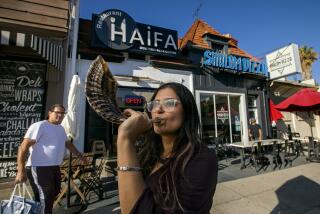Rabbi Right at Home as Temple Beth Hillel Celebrates 50 Years
VALLEY VILLAGE â It seems like Rabbi James Kaufman has always been around at Temple Beth Hillel, the first and largest Reform synagogue in the San Fernando Valley, which observes its 50th anniversary Sunday.
âIn his youth youâd see Jimmy Kaufman the song leader walking around with his guitar,â said Nancy Endman, a past president of the synagogue. âHe still carries his guitar around--heâs like a Pied Piper with the kids--even though heâs the rabbi now.â
In fact, Temple Beth Hillel may be distinctive in Southern California for having both a senior rabbi and a cantor who grew up in the same congregation. Cantor Alan Weiner, 49, joined the staff three years ago.
âThis temple carries a lot of memories for me, including my bar mitzvah,â said Weiner, who was previously cantor for 11 years at a Newport Beach temple.
Kaufman, asked if he and Weiner have disproved the truism that âyou canât go home again,â replied this week, âIt depends: If you expect to be treated like little Jimmy, it wonât work. They want a rabbi.â
Kaufman, who has been away from the Valley and Los Angeles only for three years while in the seminary during the early 1970s, was hired as an assistant rabbi to the late Rabbi Morton Bauman in 1973. He became the senior rabbi four years later.
Despite his 24 years in the pulpit at Temple Beth Hillel, the 52-year-old Kaufman is by no means the senior rabbi in terms of synagogue service in the Valley. Rabbi Meier Schimmel has been at the small Congregation Beth Meier, Studio City, for more than 40 years. Rabbi Eli Schochet has been at West Hillsâ Shomrei Torah and a predecessor synagogue for 37 years and at least three other Valley rabbis also have longer tenures than Kaufman.
The 1,000-family Temple Beth Hillel--though happy with its home-grown senior rabbi and cantor--had to make a tough decision two years ago on whether to stay in the East Valley or relocate westward to follow the Jewish population shift.
âThe congregation decided in a vote two years ago that in the long run the synagogue was sustainable in the East Valley if we keep a high level of programs,â Kaufman said. âOur biggest problems are electrical and plumbing in a building that is 42 years old; we know in five to six years weâre going to have to spend $2 million to $3 million on renovation.â
The rabbi said that membership had been gradually increasing until the 1994 Northridge earthquake, which provoked some longtime members to move out of the area.
In the meantime, Temple Judea, which has a satellite campus in Calabasas, has climbed to about 900 member families to threaten Temple Beth Hillelâs long distinction as the largest Reform synagogue in the Valley.
âOur overall membership has leveled out,â Kaufman said, âbut enrollment in our religious school, early childhood school and day school is up.â
The day school has children only in kindergarten through second grade now, but it will expand each succeeding year as todayâs second graders grow, the rabbi said.
Temple Beth Hillel got a late start, compared with other Valley synagogues, in establishing an elementary school for Jewish children.
âA number of Jewish schools opened in the Valley in 1977 when mandatory busing came,â Kaufman said, referring to the flight from public schools at that time. âOur congregation wanted a day school too, but I was opposed to it because I felt we should support the public schools.
âI put my kids on the buses,â he said. âBut then four or five years later, it seemed that busing wasnât the solution.â
By the 1980s, however, there was either a lack of interest or a lack of money to launch a day school. A financial angel in the congregation finally made it possible in the â90s, he said.
Kaufman remains a liberal on social issues. He is active in the Progressive Religious Alliance in the Los Angeles area and his congregation is a founding member of the Interfaith Food Pantry in North Hollywood.
âWe store and bag all the food in our basement, then deliver it to North Hollywood First Christian Church, which distributes the food,â said Kaufman. âThe pantry feeds about 5,000 people a month.â
More to Read
Sign up for Essential California
The most important California stories and recommendations in your inbox every morning.
You may occasionally receive promotional content from the Los Angeles Times.










